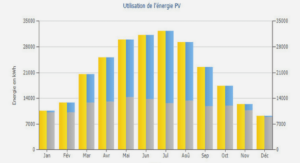Effet d’un prétraitement par une alternance de cycles courts lumière/obscurité sur la tolérance du tabac (Nicotiana tabacum L.) vis-à-vis du clomazone
Pretreatment with Alternation of Light/Dark Periods Improves the Tolerance of Tobacco (Nicotiana tabacum L.) to Clomazone Herbicide M. Darwish, F. Lopez-Lauri, M. El Maataoui, L. Urban, H. Sallanon, Pretreatment with Alternation of Light/Dark Periods Improves the Tolerance of Tobacco (Nicotiana tabacum) to Clomazone Herbicide, Journal of Photochemistry and Photobiology B: Biology 134 (2014) 49-56 Dans le chapitre précédent, il a été montré que le clomazone induit un stress photooxydatif chez la variété la plus sensible Virginie. Des donnés bibliographiques ont décrit des effets stimulant la croissance et les mécanismes antioxydants chez des algues lors d’application de lumière intermittente (Sharkey et al., 1986; Nedbal et al., 1996; Merchuk et al., 1998). Dans ce travail nous avons appliqué à la variété Virginie un prétraitement de 3 jours pendant lesquels la durée de l’alternance lumière/obscurité était de 16 min/ 8 min, une semaine avant le traitement avec l’herbicide. Comme dans les chapitres précédents, ont été suivi les teneurs en pigments, l’efficacité du PSII via les paramètres de la fluorescence chlorophyllienne et le test OJIP, les teneurs en H2O2 et les activités antioxydantes des enzymes du cycle Asada-Halliwell. Expérimentation min sous une intensité lumineuse de 50 µmol photons m−2 s−1 pendant 3 jours. L’autre partie des plantules est cultivée sous une alternance lumière/obscurité de 16 h/ 8h. Après une semaine de croissance à 22 °C le jour et 17 °C la nuit, avec une humidité relative de 60 %, des cycles jour/nuit de 16 h/8 h et une intensité lumineuse de 50 µmol photons m−2 s−1, les plantules ont été traitées avec 1 µM de clomazone pendant 14 jours.
Le prétraitement par l’alternance de cycles courts de lumière/obscurité a amélioré la tolérance des plantules de tabac face au stress photooxydatif induit par le clomazone. Ce prétraitement a augmenté la surface foliaire de la plante, l’efficience photochimique maximale du PSII (Fv/Fm), l’efficacité réelle du PSII (ФPSII), l’indice de performance (PIabs), le flux d’électrons au-delà de QA (1–VJ), et a également diminué la dissipation d’énergie sous forme de chaleur (DI0/RC). De plus, ce prétraitement a conduit à une diminution de l’accumulation d’H2O2 et une augmentation de l’activité des enzymes de détoxification (APX, MDHAR, SOD, GR et DHAR). Conclusion Le prétraitement par l’alternance de cycles courts de lumière et d’obscurité améliore la tolérance des plantules de Nicotiana tabacum L. Virginie vk 51 au clomazone. Cette amélioration semble provenir de la stimulation de l’activité des enzymes antioxydante dans le chloroplaste qui protège l’appareil photosynthétique des effets directs des ERO et élimine des électrons en excès dans la chaîne de transport.
The photosynthetic reactions in higher plants are piloted through the cooperation of the two photosystems, PSI and PSII [1,2]. Light energy is collected by the antenna of PSII and PSI (LHCs) and is channeled to the reaction centers (RC). In most of the cases, where plants are exposed to herbicides, the electron transport will be blocked and the QA will stay in a reduced (OH−). However, 1O2 seem to be the major reactive oxygen species involved in photooxidative damage to plant [5]. The herbicide clomazone belongs to the class isoxazolidinone [2-(2- chlorobenzyl)-4,4-dimethyl-1,2-oxazolidin-3-one]. It is a pre-emergence herbicide, widely used in agriculture for the control of annual weeds in soybean, cotton, sugar cane, maize, rice and tobacco [6]. Clomazone treatment can lead to decrease in the antenna pigments of the photosynthetic apparatus; consequently, it leads to photooxidative stress which can inhibit the PSII [7]. It is important to know that the variation of intensity and duration of light may produce modulation of the response of plants to biotic and abiotic stress, this in turn can be explained by the accumulation of ROS [8-10]. These ROS are thought to be one of the primary causes of the irreversible loss of photosynthetic activity, which is observed in the plant leaves exposed to light in combination with the environmental stresses [11-13]. However, plants have developed numerous mechanisms to protect the photosynthetic apparatus against photooxidative damages. This involves modifications in the amount of the soluble enzymes, the components of the electrons-transport, and the pigment-protein complexes which are effective mechanisms to match the available amount of light with the very capacity of the plant itself to absorb it for carbohydrate synthesis [14]. Moreover, antioxidant systems are considered as another mechanism by which the photooxidative damage induced by the herbicides is considerably reduced. Indeed, plants have two antioxidant defense systems: enzymatic and non-enzymatic scavenging systems. Enzymatic antioxidants system includes superoxide dismutase (SOD) and catalase (CAT), and the enzymes belonging to Ascorbate-glutathione cycle such as ascorbate peroxidase (APX), monodehydroascorbate reductase (MDHAR), dehydroascorbate reductase (DHAR), glutathione reductase (GR), whereas non-enzymatic antioxidant system includes some compounds such as ascorbic acid (AsA), glutathione (GSH).





